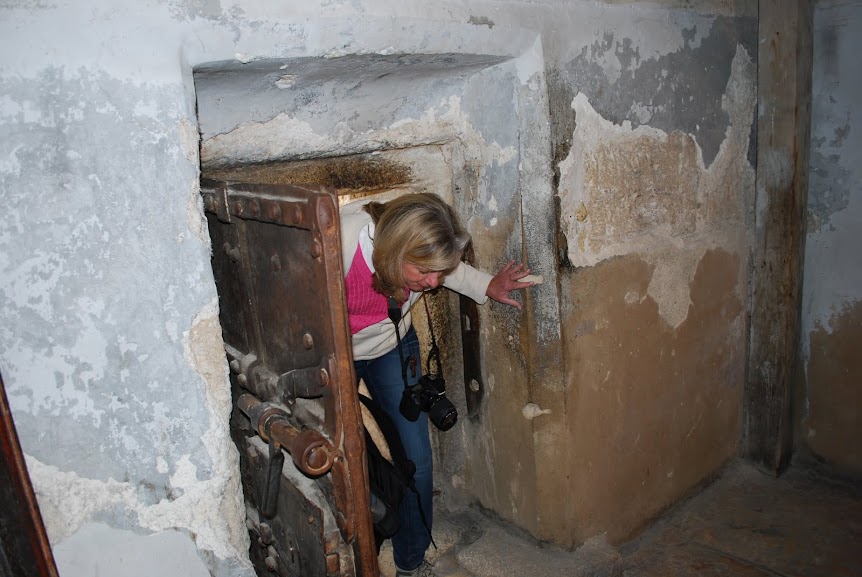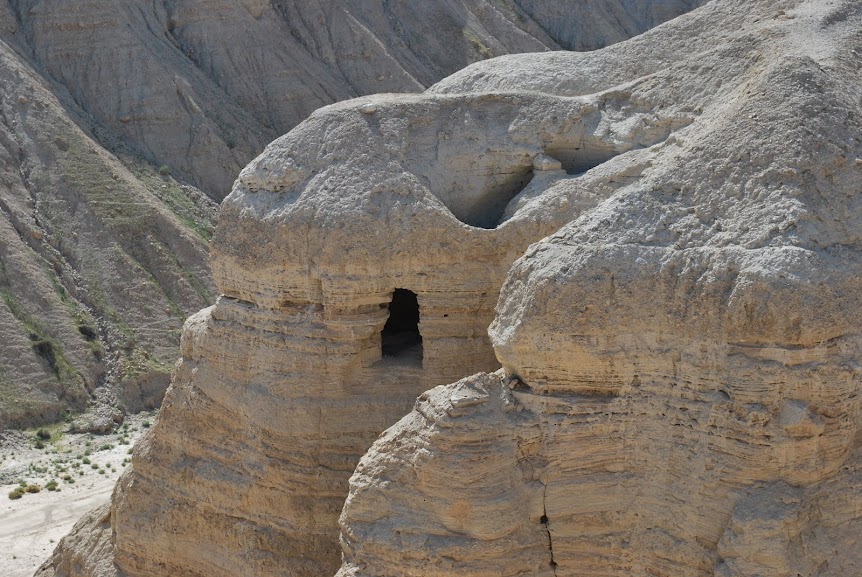In the fall of 2014, I am leading a tour to Israel. Back in 2010, I made my first pilgrimage there, and I have many fond memories of that trip. In the next few weeks, I want to share with you some of my memories of Israel. Here is part two - Southern Israel.
After our days around the Sea of Galilee, we traveled south
along the Jordan
River,
and the area became more and more desolate, dry and barren. We headed
toward the Dead
Sea,
some 1200 feet below sea level, then headed west toward Jerusalem, climbing up to 2500 feet
above sea level. You always travel UP to Jerusalem. Along the way
we passed along the Mount of Temptation, where a monastery has been built on
top commemorating Jesus’ temptation in the wilderness. I have a new
appreciation for “wilderness” now when we read Matthew 4.
 We drove past Jerusalem and headed to Bethlehem – a very short distance (less than 8 miles, I would say). It was there that we had to get off the bus, pass through a security checkpoint and enter into the area under Palestinian rule – Bethlehem is in this area. We met a new guide and driver, as our Jewish driver and guide are not permitted into the Palestinian areas. The streets of Bethlehem were VERY crowded, and there were many trying to sell us scarves, wooden carvings, necklaces and more. We got on our bus and headed to a gift shop, where there is a lot of olive wood carvings and Mother of Pearl figurines and jewelry. Lisa and I bought a Nativity Set and some gifts as well.
We drove past Jerusalem and headed to Bethlehem – a very short distance (less than 8 miles, I would say). It was there that we had to get off the bus, pass through a security checkpoint and enter into the area under Palestinian rule – Bethlehem is in this area. We met a new guide and driver, as our Jewish driver and guide are not permitted into the Palestinian areas. The streets of Bethlehem were VERY crowded, and there were many trying to sell us scarves, wooden carvings, necklaces and more. We got on our bus and headed to a gift shop, where there is a lot of olive wood carvings and Mother of Pearl figurines and jewelry. Lisa and I bought a Nativity Set and some gifts as well.
We then headed to
the Church of the Nativity in Bethlehem (the city is much hillier
than I ever imagined it would be). The church is owned by three
congregations – Greek-Orthodox, Catholic and Armenian. To enter the
church, one must enter a door that is maybe four feet high at the most – this
is called the Door of Humility – where one must bow to enter. When we entered,
there was a Greek-Orthodox service and Catholic service going on – the line to
see the “place where Jesus was born” under the altar of the church was 90
minutes long.

As we waited, we did get to
see a bit of the splendor of the Greek-Orthodox service, which I thought was
great to see. When we left the church, we drove past the shepherds field,
where the angels appeared to the shepherds that holy night. Along the
road, we saw a coffee shop called “Stars and Bucks” – looking a LOT like our
American coffee houses!

After a night in our hotel in Jerusalem, we
started our descent to the lowest place on earth –
the Dead
Sea.
The Dead
Sea
is 1300 feet below sea level – Jerusalem is 2500 feet ABOVE sea
level. We traveled east to the Dead Sea, then headed south to Masada. Masada is located on the
mountains/hills along the west side of the Dead Sea near its southern
point. Masada was first built by Herod
just before the life of Jesus, as an escape from the pressure of Jerusalem. He was a bit
paranoid of his role, and wanted a place where he could look over his area of
command, but be distant from it. How he picked this location, I
haven’t a clue. Desolate, isolated, far away from much of anything.
He built quite a structure there. It sits some 200 feet above sea level –
a good 1500 feet above the Dead Sea.

In
66 AD, the Jews
overtook the fortress. We do not know about how that came about, but when
Jerusalem was destroyed by the Romans
in 70 AD, many made their way to safety at Masada. It was the last
stronghold of the Jews in Israel at that time. The
Romans cornered the people there, and laid siege against the compound for
nearly a year, but the people had stored up so many resources and supplies,
they were able to withstand the siege. Over that time, the Romans built a
ramp to attack the compound with a battering ram, and when through the first
stone wall, burned down the wooden second wall.
 The rampart was
complete in the spring of 73, after approximately two to three months of siege,
allowing the Romans to finally breach the wall of the fortress. When they
entered the fortress, however, the Romans discovered that its 960 inhabitants
had set all the buildings but the food storerooms ablaze and committed mass
suicide rather than face certain capture, defeat, slavery, or execution by
their enemies.
The rampart was
complete in the spring of 73, after approximately two to three months of siege,
allowing the Romans to finally breach the wall of the fortress. When they
entered the fortress, however, the Romans discovered that its 960 inhabitants
had set all the buildings but the food storerooms ablaze and committed mass
suicide rather than face certain capture, defeat, slavery, or execution by
their enemies.
The structure is
incredible. A cable car carried us up to the structure, and we spent a
great deal of time walking around and seeing how the people survived, and the
sacrifice they made to die rather than face the Roman tyranny.
 After Masada, we headed to lunch, then a short visit at Qumran, where the Dead Sea scrolls were found in 1947 by Bedouin shepherds. The find happened when a stone was thrown into a cave, and it made a strange noise. Going into the cave, the shepherds found jars with scrolls wrapped in leather. The interest was first more in the leather. As it was passed on and sold to various owners, the importance and value increased.
Copies of Old Testament Scripture,
Apocrypha, and other writings were found. It is believed these were
written by Essenes – Jewish Zealots who were very devout, and lived in a desert
community. It is widely believed that John the Baptist was a member of
this radical group of Jews. A community remains have been found
near the 11 caves that have been excavated. This site is north of Masada by about 30 miles.
After Masada, we headed to lunch, then a short visit at Qumran, where the Dead Sea scrolls were found in 1947 by Bedouin shepherds. The find happened when a stone was thrown into a cave, and it made a strange noise. Going into the cave, the shepherds found jars with scrolls wrapped in leather. The interest was first more in the leather. As it was passed on and sold to various owners, the importance and value increased.
Copies of Old Testament Scripture,
Apocrypha, and other writings were found. It is believed these were
written by Essenes – Jewish Zealots who were very devout, and lived in a desert
community. It is widely believed that John the Baptist was a member of
this radical group of Jews. A community remains have been found
near the 11 caves that have been excavated. This site is north of Masada by about 30 miles.

 After Qumran, a ten minute drive north,
to the beach, where a couple of us braved the salty water. The Dead Sea is 10 times more salty than
the oceans, with many other minerals in its mud and water. Many rub the
mud all over their bodies when there, then wash off in the sea and/or
shower. It is so easy to float – I was able to hold a newspaper and read
it in the water!
After Qumran, a ten minute drive north,
to the beach, where a couple of us braved the salty water. The Dead Sea is 10 times more salty than
the oceans, with many other minerals in its mud and water. Many rub the
mud all over their bodies when there, then wash off in the sea and/or
shower. It is so easy to float – I was able to hold a newspaper and read
it in the water!
 Across the sea from
that point we could see across to the country of Jordan to Mount Nebo, where Moses was permitted
to look across the Dead Sea and Jordan River that flows into it to the
Promised Land from the wilderness. Moses was not permitted to enter the
land as he and his people had stumbled along the way, causing God to prohibit
their entry. Once Moses died, Joshua led the people through the waters to
the Promised Land.
Across the sea from
that point we could see across to the country of Jordan to Mount Nebo, where Moses was permitted
to look across the Dead Sea and Jordan River that flows into it to the
Promised Land from the wilderness. Moses was not permitted to enter the
land as he and his people had stumbled along the way, causing God to prohibit
their entry. Once Moses died, Joshua led the people through the waters to
the Promised Land.
So the best line of
the day was from Micah, our tour guide, who has the patience of Job!
Unfortunately, there are some in our tour group (not MY seven, they are GREAT
and ALWAYS on time) who are always lagging behind and slowing us down.
Someone mentioned to him that it must be frustrating. His response was,
“Now you know why Moses quit his job!”
Next week's entry, I will share with you experiences from our time in Jerusalem. If you are interested in joining us on a trip next October, there are brochures available at the church, or I can send you information.
Peace,
Pastor Charlie
 We drove past
We drove past 
 After a night in our hotel in Jerusalem, we started our descent to the lowest place on earth –
the
After a night in our hotel in Jerusalem, we started our descent to the lowest place on earth –
the  In 66 AD, the Jews
overtook the fortress. We do not know about how that came about, but when
In 66 AD, the Jews
overtook the fortress. We do not know about how that came about, but when
 The rampart was
complete in the spring of 73, after approximately two to three months of siege,
allowing the Romans to finally breach the wall of the fortress. When they
entered the fortress, however, the Romans discovered that its 960 inhabitants
had set all the buildings but the food storerooms ablaze and committed mass
suicide rather than face certain capture, defeat, slavery, or execution by
their enemies.
The rampart was
complete in the spring of 73, after approximately two to three months of siege,
allowing the Romans to finally breach the wall of the fortress. When they
entered the fortress, however, the Romans discovered that its 960 inhabitants
had set all the buildings but the food storerooms ablaze and committed mass
suicide rather than face certain capture, defeat, slavery, or execution by
their enemies.

 After
After  Across the sea from
that point we could see across to the country of
Across the sea from
that point we could see across to the country of 


No comments:
Post a Comment